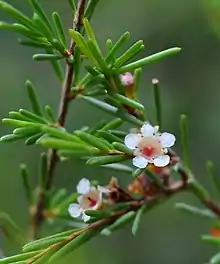Baeckea frutescens
Baeckea frutescens is a species of flowering plant in the family Myrtaceae and is native to eastern Southeast Asia, New Guinea and Australia. It is a shrub with arching branches, linear leaves and white flowers with seven to thirteen stamens.
| Baeckea frutescens | |
|---|---|
 | |
| In Belitung, Sumatra | |
| Scientific classification | |
| Kingdom: | Plantae |
| Clade: | Tracheophytes |
| Clade: | Angiosperms |
| Clade: | Eudicots |
| Clade: | Rosids |
| Order: | Myrtales |
| Family: | Myrtaceae |
| Genus: | Baeckea |
| Species: | B. frutescens |
| Binomial name | |
| Baeckea frutescens | |
| Synonyms[1] | |
Description
Baeckea frutescens is a shrub that typically grows to a height of up to 1 m (3 ft 3 in) and has arching branches. Its leaves are linear and often clustered on short side-branches, 4–10 mm (0.16–0.39 in) long and about 0.5 mm (0.020 in) wide on a petiole 0.5–0.6 mm (0.020–0.024 in) long. The flowers are arranged singly in leaf axils and are 3.5–5 mm (0.14–0.20 in) wide on a pedicel 1–2 mm (0.039–0.079 in) long. The five sepals are rounded-triangular, the five petals white, more or less round and 1.0–1.5 mm (0.039–0.059 in) long, and there are seven to thirteen stamens. Flowering mainly occurs in summer and the fruit is a capsule about 2 mm (0.079 in) in diameter.[2][3][4]
Taxonomy
Baeckea frutescens was first formally described in 1753 by Carl Linnaeus in Species Plantarum.[5][6] The specific epithet (frutescens) means "becoming bushy or shrubby".[7]
Distribution and habitat
This baeckea grows in heath and open grassland from south-east China to eastern Australia. In Australia it grows in near-coastal areas as far south as Port Macquarie.[2][3]
References
- "Baeckea frutescens". Plants of the World Online. Royal Botanic Gardens, Kew. Retrieved 18 January 2022.
- Wilson, Peter G. "Baeckea frutescens". Royal Botanic Garden Sydney. Retrieved 18 January 2022.
- "Baeckea frutescens". Flora of China. Retrieved 18 January 2022.
- Bean, Anthony R. (1997). "A revision of Baeckea (Myrtaceae) in eastern Australia, Malesia and south-east Asia". Telopea. 7 (3): 247–250. Retrieved 19 May 2023.
- "Baeckea frutescens". APNI. Retrieved 18 January 2022.
- Linnaeus, Carl (1753). Species Plantarum. pp. 358–359. Retrieved 18 January 2022.
- Sharr, Francis Aubi; George, Alex (2019). Western Australian Plant Names and Their Meanings (3rd ed.). Kardinya, WA: Four Gables Press. p. 202. ISBN 9780958034180.
- Tan Cheng Li (3 May 2016). "Unique plants in a scanty forest" (PDF). Star2. The Star. p. 5. Retrieved 19 May 2023 – via Forestry Department Peninsular Malaysia.